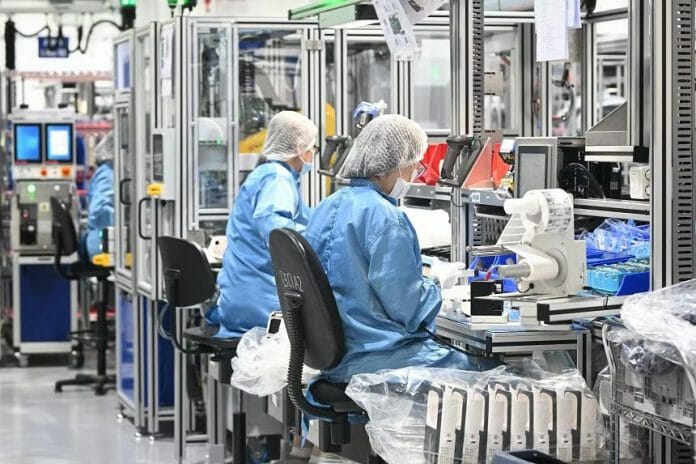Singapore’s Manufacturing output fell in December, largely due to a -24% plunge in the volatile biomedical cluster. Industrial production declined by -2.5% from a year ago (vs. a downward-revised 0% in Nov), while falling -1.7% in seasonally-adjusted month-on-month terms.
Maybank Research Pte Ltd, in a note today (Jan 29) said excluding biomedical manufacturing, output grew +0.5% from a year ago (vs. a downward-revised +1.1% Min Nov), while rising +3.6% from the previous month.
For the full year, manufacturing contracted by -4.3%, or -3.6% if the biomedical cluster is excluded.
Electronics Recovering
Electronics output grew +6.3% in December, faster than the +5.1% rise in November (which was albeit revised down from the previous print of +7.3%). This contrasts sharply with the nearly -12% drop in electronics exports, which may have been disrupted by the Red Sea crisis and Panama Canal drought.
Electronics growth was led by semiconductors (+17.7% vs. +5.7% in Nov), owing to improved demand in selected end markets such as smartphones. Other products remained in a slump. Computer peripherals and data storage (-17% vs. -8.3% in Nov) saw a 10th straight month of decline, while Infocom & consumer electronics (-18.1% vs. +12.6% in Nov) and other electronic modules or components (-7.8% vs. +2.6% in Nov) returned to contraction.
Chemicals (+2.8% vs. +2.6% in Nov) saw a second straight month of growth, following 15 months of contraction.
Output was supported mainly by specialties (+29.1%), due to higher production of mineral oil additives. Petroleum output (+1.7%) grew for a third consecutive month. In contrast, petrochemicals (-5.5%) saw a 23rd month of decline, weighed down by weak market demand.
The reopening tailwind is fading for transport engineering, which rose +0.2% year-on-year (vs. +8.6% in Nov), its slowest growth since March 2021. The main drags were a -1.7% decline in the marine & offshore segment and a -10.8% fall in the land segment, which EDB attributed to a high base in Dec 2022.
The aerospace segment grew +4.9% with higher demand for aircraft parts and more maintenance, repair and overhaul jobs from commercial airlines, amid the global air travel recovery.
Biomedical, Precision Engineering and General Manufacturing Were Drags on Growth
Biomedical manufacturing plunged -23.9% from a year ago in December (vs. -2.8% in Nov), led by pharmaceuticals (-45%) due to lower production of biological products and a different mix of active pharmaceutical ingredients being produced.
In contrast, medical technology output climbed +8.6% with higher export demand for medical devices, its fastest pace since March.
Precision engineering (-7.4% vs. -12% in Nov) fell for the 10th consecutive month, weighed down mainly by precision modules & components (-24.7%).
Machinery & systems output declined -1.8%, largely due to lower production of measuring devices and mechanical engineering works.
General manufacturing slumped -15.9% following two months of growth, with a broad-based decline across printing (-16.7%), food, beverages & tobacco (-12.9%) and miscellaneous industries (-20.2%).
Manufacturing Recovery Intact; Expect Cut in 4Q Final GDP to +2.5%
The manufacturing recovery remains intact, led by a pickup in the global electronics cycle.
Demand conditions are improving when volatile swings in biomedical output are stripped out, with ex-bio industrial production having seen positive growth for four straight months.
This corroborates other high-frequency indicators such as improving manufacturing and electronics PMIs and export orders, as well as a recovery in the exports of other trade-sensitive Asian economies. Global semiconductor sales increased +5.3% YoY in November, its first rise in over a year.
The December slump in Singapore’s non-oil domestic exports may prove temporary given the manufacturing recovery, notwithstanding further escalations in logistic and shipping disruptions from the Red Sea and Panama Canal.
Factors driving the manufacturing recovery include the tech replacement cycle as new models and upgrades are released; the AI boom; depleting US inventories; generous US subsidies on semiconductors and electric vehicles; and a shift in consumer spending back towards goods as revenge spending on services fade.
Maybank Research maintains their 2024 GDP growth forecast at +2.2%. Fourth quarter manufacturing growth is at +1.4%, undershooting MTI’s advance estimate of +3.2%. They expect 4Q final GDP (out in Feb) to be revised down to around +2.5% (from the flash estimate of +2.8%).
This implies that full year 2023 GDP growth may be revised down slightly to +1.1% (from the flash estimate of +1.2%).
Maybank Research expects the MAS to maintain the current appreciation stance in its upcoming quarterly meeting on 29 January, given the economic recovery and elevated core inflation.









